Fine Specimens of Snow Building
What snowstorm of this caliber wouldn’t necessitate building a snowman? Indeed, Houston and the Gulf Coast put on their best displays. Houston’s snowmen received rather detailed news coverage:
“In the Fourth Ward (north) may yet be seen fine specimens of snow building, the work of artistically inclined citizens. A man in an attitude of prayer kneels on a mammoth ball of snow at Mechanic 6’s engine house. Mr. George Rooney architect: grandpa with his overcoat on and broom in hand looks from the yard of Mr. J. Krohn; a bride with trailing trousseau and poke bonnet is admired by passers-by in the yard of Professor Charles Felton; George Washington with a cob pipe in his mouth watches the pedestrians on Washington Street from the yard of Mr. Albert Gregor, and others in out of the way places.” – Houston Post, February 17, 1895
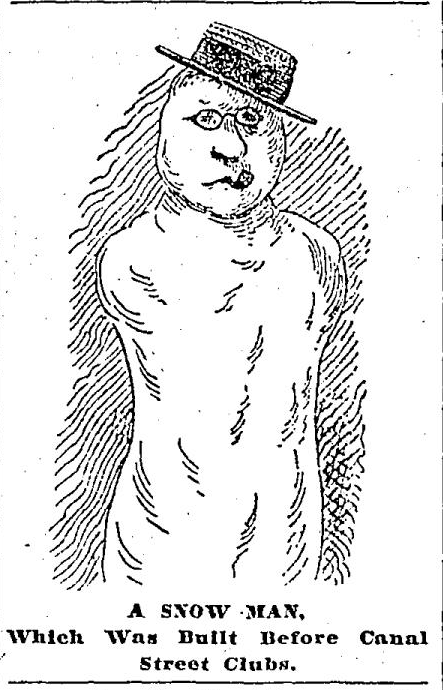
Galveston held their own too. As the Daily News reported on Saturday the 16th:
“There were many snow men created yesterday. Some of them were unlike anything in the heavens above or in the earth beneath. They were fearfully and wonderfully made. The biggest and most attractive of these being strange to Galveston is that at No. 2210 avenue M. The creators and sculptors are Messrs. Kennedy, Barry and Elbert, who took three hours to finish their work. They trusted to the approaching norther to put breath into an otherwise life-like snow man. This statue will measure 9 feet in height. On his head is a hat of the obsolete fashion worn by Uncle Sam, whiskers of holly twigs adorn his face and give play for the wind. His mustache is of cedar leaves and his hair of oleander leaves. His eyes are of pecans and row of buttons down his front is of pecans also. The arms extend outward and slightly upward. The nose, cheeks, neck, and body were carved with a butcher knife and are like other people’s noses, cheeks, and necks.”

Clearly, despite not being familiar with snow on the Gulf Coast, people got the hang of it quickly. There were other amusing and interesting stories too. A farmer from just outside Houston shared a letter with the Houston Post from his farm manager. The letter read:
“Dear Sir: The snow is twelve inches on the level and still snowing. You need not be uneasy about the outdoor stock. I have got all of them up around the barn and am feeding them. We have one young colt, two young calves and six little pigs. The pigs I have in the house by the fire. Everything is O.K.”
In Galveston, a group of investors from Des Moines, Iowa were visiting during the snow. According to the Daily News, they “came to Galveston to bask in sunshine and pluck flowers from open gardens, spent yesterday hugging a cheerless radiator at the Tremont and left in the evening for San Antonio.” From San Antonio, they were slated to go to Monterey, and if they didn’t “find warm weather there, they vow they will continue to the equator.”
Many people know Dr. Isaac Cline from the 1900 hurricane, and the book “Isaac’s Storm,” but he was in charge of the weather bureau office in Galveston during the 1895 storm as well. Cline “didn’t do a thing (on Valentine’s Day) but stand at the telephone and answer inquiries.”
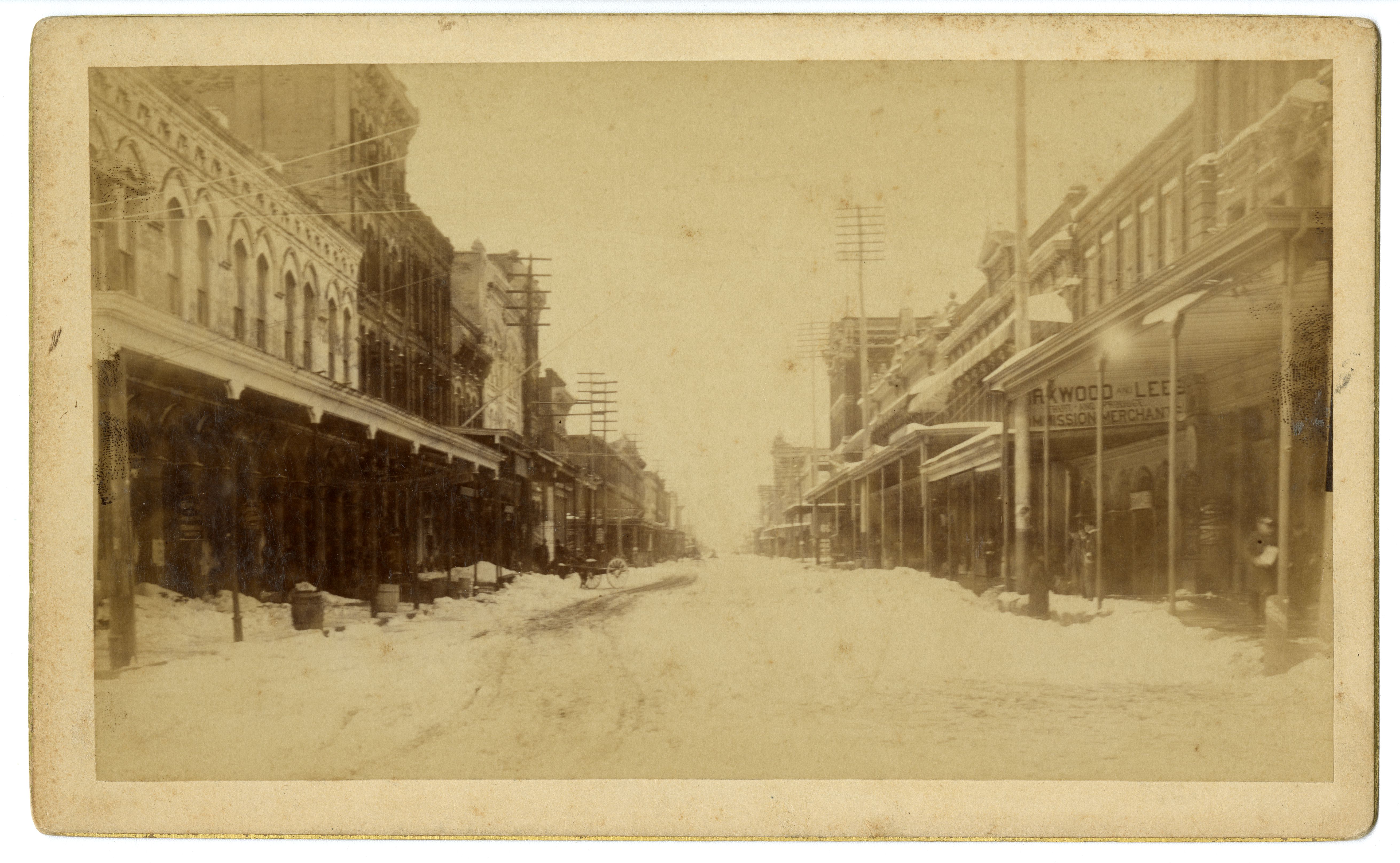
The Daily News in Galveston summed up the plight of stranded train travelers rather eloquently.
“There was no merriment to be had from the storm in that portion of Galveston. Of all places in the world to wait, the waiting room of an average Texas depot is the worst, and Galveston’s station is not one to laud in picture books of buildings to which people point with pride. It is a cold and dreary place, and belated passengers peppered the genial Perrett (railway official) with enough interrogations to have bankrupted a type foundry of question marks had each been printed.”
Alvin’s oldest inhabitant was “snowbound and cannot be seen. As soon as he thaws out he will be interviewed.” The Galveston Daily News published a rather self-aware poem on February 17th.
The Texas Coast Land
Beautiful for situation,
Dates and palms at every station,
In the Texas coast land.Leave your frozen, icy north,
Take your baggage and go forth
To the Texas coast land.If you want delightful breezes
And would ‘scape continual freezes,
Seek the Texas coast land.If you’re tired of furs and wraps
And all the similar kind of traps,
Find the Texas coast land.If you like the sun each day,
Hear what I have got to say:
It’s in the Texas coast land.If you’ve enough of sleigh-bells ringing,
And would hear the sweet birds singing,
Hie you to the Texas coast land.The beautiful Texas coast land,
Where there surely is lots of sand,
Where the flowers bloom throughout the year,
And the people all are full of cheer.If you think it doesn’t freeze here,
Ne’er grows cold, and never snows here,
Then surely you should have been here
On the day you see below here,
For it surely was a hummer,
And proved it is not always summer
In the Texas coast land.Galveston, Feb. 14, 1895.

Perhaps the Galveston Daily News summed it up as best as any Texas or Gulf Coast resident could. “As improbable as it may seem to you, we are going to be longing for some of this snow next summer.”
“Cattle Loss of Fully 10 Percent”
While the snow was certainly beautiful and a source of great amusement, there were other unfortunate and serious stories to share. Near Beaumont, a gentleman named Berry Billus was found dead in the snow on Friday the 15th. It was presumed he fell down, was unable to get up, and simply froze to death. Someone named Jack Gibson was found frozen to death near Round Rock, outside Austin, after injuring his hand.
In Clear Creek, near present day League City, large herds of loose cattle made it dangerous for people to get about town, and a woman, presumably fleeing a longhorn, fell down. “The beef fell in the ditch and was soon covered with snow. Many cattle have fallen and many more will die tonight,” reported the Daily News. Though no accurate final tally exists, thousands upon thousands of cattle perished in the extreme weather. Abe Head Pierce (also known as Shanghai Pierce) was a leading expert on cattle at the time. He was quoted as believing approximately ten percent of all Texas cattle would be killed because of the extreme cold and snow.
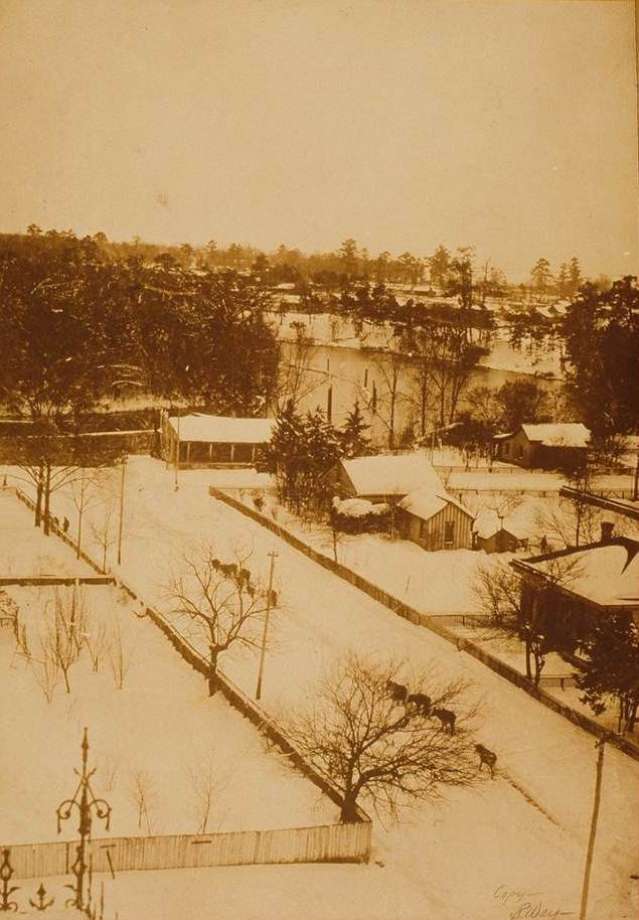
Management of cattle may have inadvertently contributed to their demise. Wire fencing was still relatively new at that time. It worked to cut off stock from food and shelter. As it was described by members of the Southern Texas Livestock Association, “The loss is greater today than it would have been ten or fifteen years ago, other things being equal, because of the wire fencing that has cut the stock off from the bottoms. Cattle will never move against the wind, rain, sleet, or snow, but drift with it as soon as it starts. They used to turn their backs to the northers and gradually drift into the bottoms, where they would get protection by the trees and find some kind of green food that would keep life in them ‘till the severity of the cold passed. Now it is different. They are driven by the cold against some wire fence and there they stop and freeze and starve to death.” The Livestock Association estimated stock losses to be greater than 25 percent.
Losses weren’t limited to cattle. In Genoa, near present day Hobby Airport, numerous birds, robins in particular, could not handle the cold and snow and were found lying dead about the area. For southwest Louisiana, Cameron Parish saw thousands of cattle reportedly killed, in addition to many orange trees.There were several reports of shipwrecks off the Texas coast, though none serious as far as my research found.
Brownsville, in far South Texas, received a record of around five inches of snow. The Brownsville Daily Herald issued an appeal to its readers to help the less fortunate because of suffering:
“There is undoubtedly much suffering among the very poor of this place, due to the cold. Many of the jacals which serve as dwellings for from one to a dozen or more persons consist of a single room built of rude brush and grass, through the cracks of which the snow enters almost as freely as it falls outside. Those of our citizens who are in comfortable circumstances should do all in their power to alleviate the distress of these poor creatures. Give what you can spare to the needy ones today and give it with a willing hand.”
Back in Houston, there were serious concerns over structural integrity, as many roofs (especially flat ones) were never constructed with snow in mind. There were some incidents noted. The Perry Building, located at Congress and Fannin lost its awning, as the weight of the snow was too heavy. A drug store on Main Street suffered the same problem, while the Macatee Warehouse on Washington Avenue lost part of its rear wall. It’s likely that many people suffered leaky roofs after this storm.
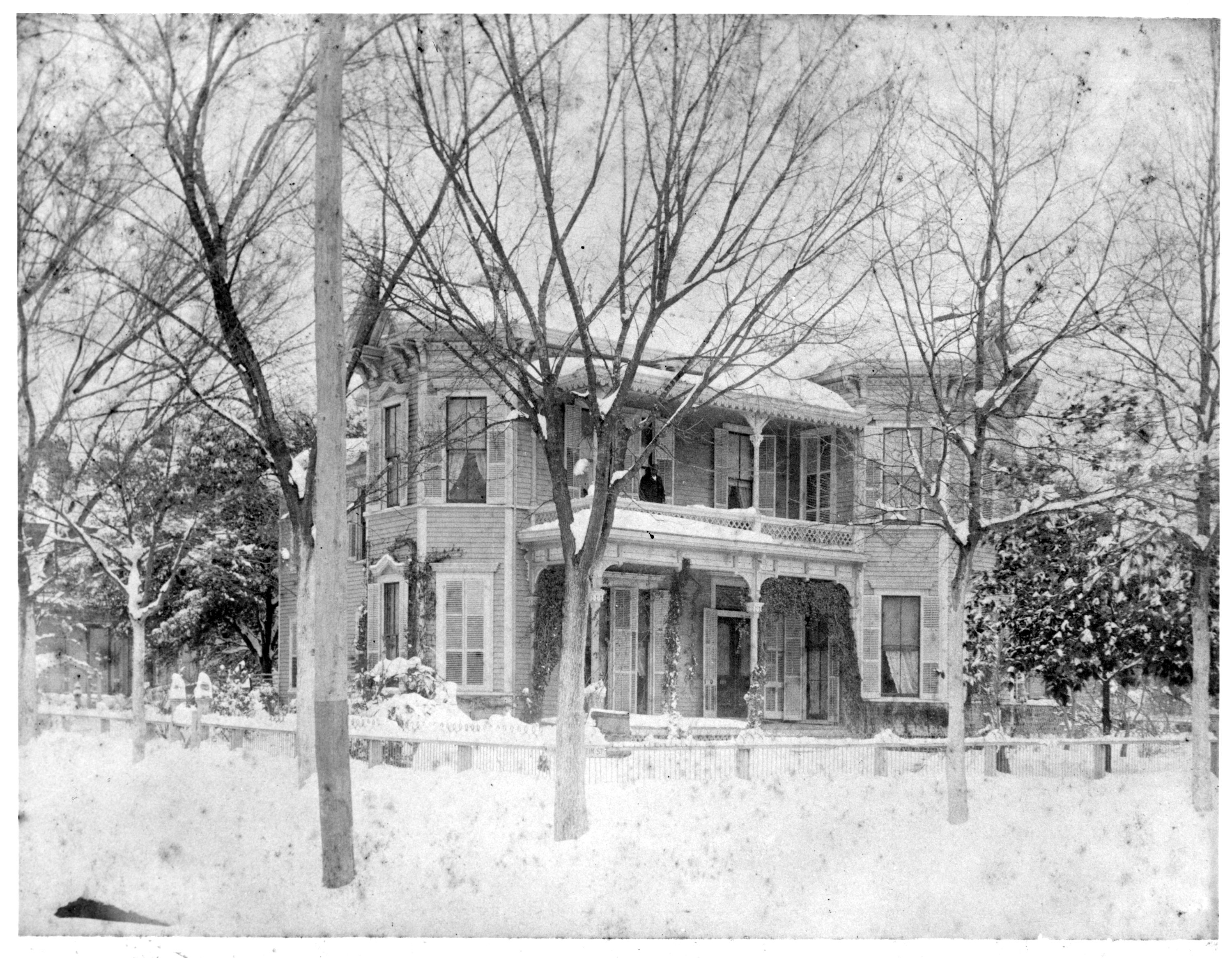
By Saturday, Houston’s 20 inches of snow had reduced to about six to eight inches, and “sleighing was little better than pulling through the mud.” And also by Saturday, streetcar service was back up and running in places like Houston, Galveston, and New Orleans, but not after suffering tremendously during the storm.
In Houston, the Post reported that the street car company was “perhaps the worst sufferer by the present state of the weather.” Streetcars were abandoned at Main and Preston, as the snow “kept falling with almost blinding rapidity.” By 10 AM on Valentine’s Day, street car service had essentially shut down, which forced streetcar company workers to get creative. In Houston, that meant constructing an iron snow plow in about a day. By midday Friday, the plow was attached to a street car and pushed by two motors. It did good work until it hit a drift on McKinney Street and broke. Wooden plows were also constructed, continuing the work all afternoon, and the street car system was fully operational by Saturday.
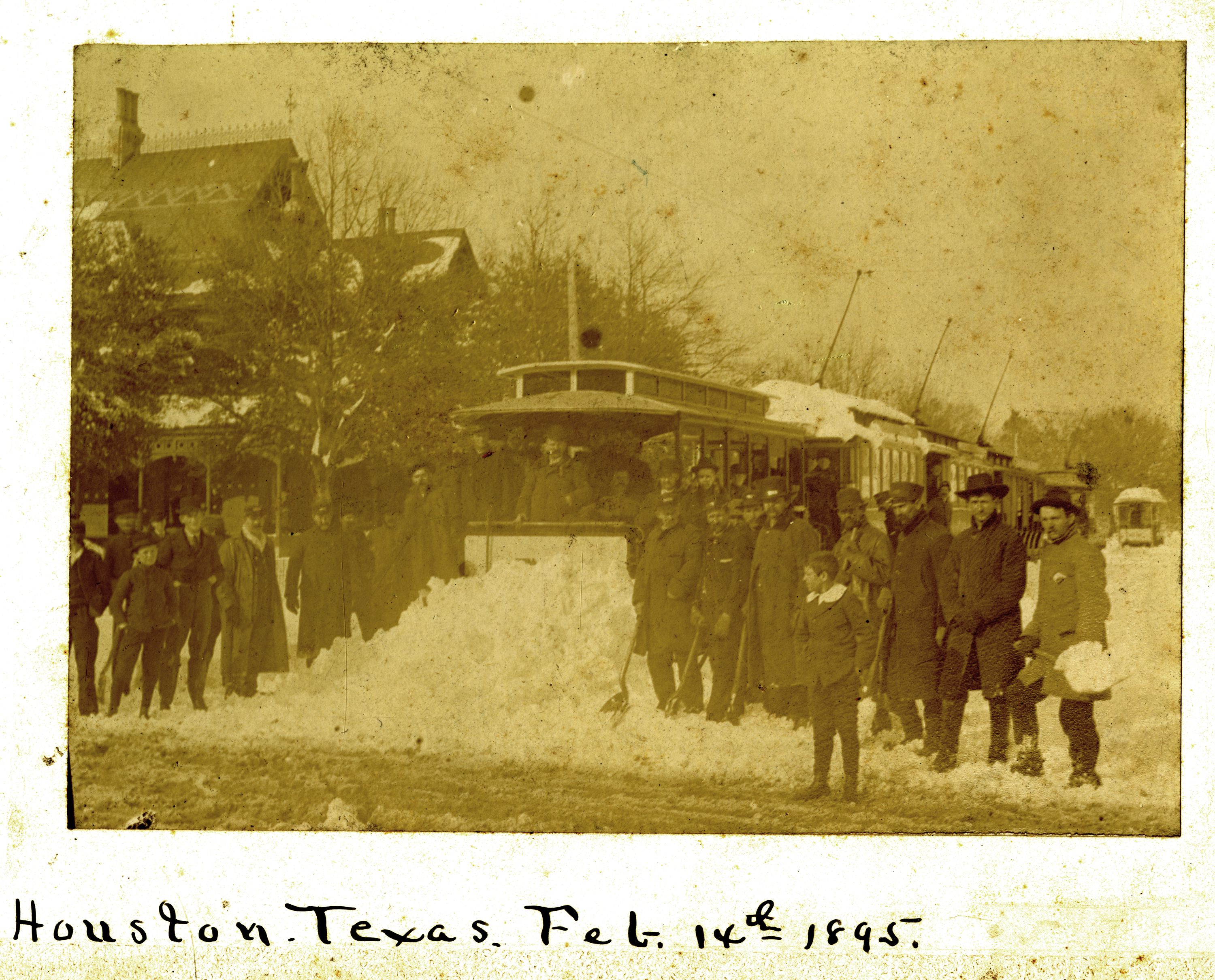
“Paralyzed” was the word used to describe Galveston’s streetcar service, according to the Daily News. The Railway Company made an effort by sending out a dust sweeper, but as you might expect in two to five foot drifts, this didn’t work. “Southern street railways are equipped with all the modern improvements for keeping passengers cool,” the paper reported, “but when it comes to Arctic blizzards they quietly refrain from idle boasting.” Like their counterparts in Houston, the Galveston’s streetcar company developed a plow of their own. It took some effort, but within a couple days, all was back to normal there also. The head of the Railway Company said he would “donate the snow plow to the Texas historical society of Galveston when he gets through with it. He never anticipates having to use it again.”
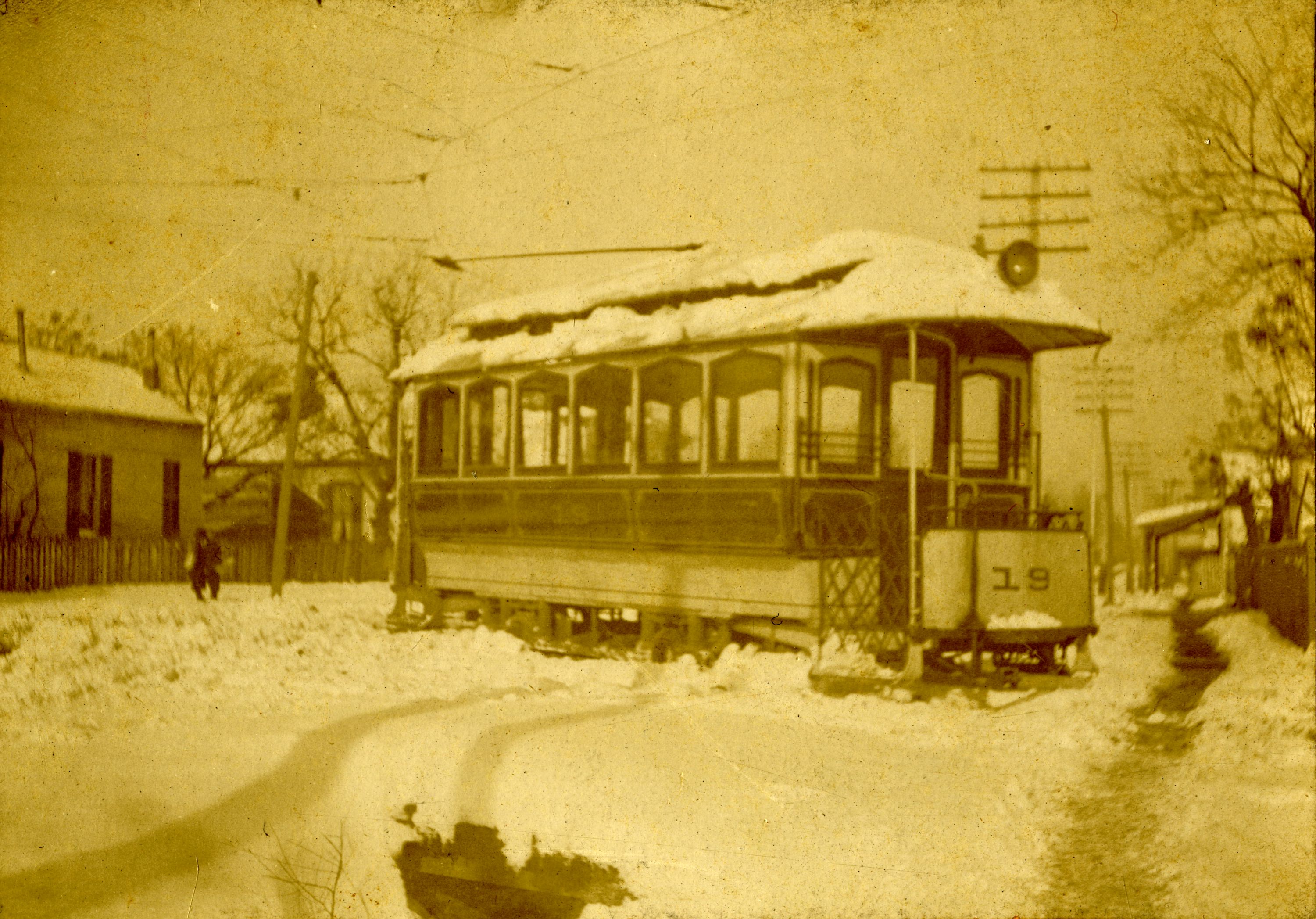
New Orleans had many of the same problems. The general mood was cheerful, but as street cars ran slower and slower, with more delays, problems began to pile up. Like in Galveston, dust brushes were the primary means of trying to clear snow. Obviously this failed, and eventually, the majority of New Orleans street cars came to a halt. Mule cars tried to pick up some of the slack, but they failed also. As the Picayune reported, “There was a mournful-looking line of cars, each with a forlorn looking mule attached to it, standing on Canal Street, with a few people who still vainly hoped that they would get home by the cars, sitting or standing impatiently in them.” The situation returned to normal after a couple days, once melting began and a plow was constructed.
On a slightly more positive note, shoe retailers cashed in from the snow and muddy mess. Sales of boots and overshoes in Houston on Valentine’s Day exceeded the combined sales of the previous seven years.
(Post continues on next page)
BRAVO!!! What a great, well researched piece and all the stories within the story…loved the old pictures…sure wish we still had some of those beautiful old buildings…a number of chuckles, especially reading about state legislators in Austin dodging snowballs trying to exit the capitol…guess citizens back then shared differences with politicians…imagine that!
Thanks, Milt! Stories like this definitely make you appreciate the good parts of the past. I just can’t imagine seeing how beautiful Houston must have looked on Valentine’s Day morning that year.
Thanks for sharing!
Awesome stuff. Loved every bit!
Thanks, Brad!
Very interesting! Would love to experience snow again someday.
Agreed. Doubt we’ll see a storm of this magnitude/scale again, but we’ll probably see snow again one day.
Thank you, Matt! This was a treat to read. Wish something like this would happen again for us …
Thanks, Katie! It would be pretty incredible to see it happen again for sure!
What a fabulous and fascinating presentation! Thank you so much for all your work in doing this!
Thanks, Susan!
History can be so fascinating. And snow is so magical to us native Houstonians.
I loved the way this was put together, Matt. I always look forward to these forays in the past. Thanks so much for your effort.
What a fun read and the research needed to put this together must have taken weeks. The other take away is the prose contained in the newspaper reports. Just amazing.
fantastic article. Must have been strong upper feature following on front. dwarfs the 4 inches I say in College Station Jan 1964.
Thank you, Joe. Yes, I think a front followed by some wild upper level system digging out of the Southwest set off a fuse in the Gulf. Would be absolutely incredible to witness today.
Cool!
Oh my Goodness….Milt…..THANK YOU so very much for researching and writing this article …..please pass your information to the State of Texas historical society for I am sure the information will be read for generations to come. As a lifelong resident of Oklahoma I found the letter from Medford OK pleading for help from the people of Galveston particularly interesting. The letter shows multiple points about the histories of both Oklahoma and Texas. It proves, once again, that there were many people already homesteading in Oklahoma….waaaay before the 1901 Land Lottery. Once again, we earn the name Sooners . . . it also serves to remind US ALL….the citizens of Texas and Oklahoma……that no matter the scores in various competitions between Oklahoma / Texas (Texas / Oklahoma…..for Texans reading this)…..no matter the heated competitions……that our two states have a long history of coming to aid each each other through thick and thin……….WE help each other. My heart broke for Houston after Hurricane Harvey. I was also terrified having a nephew and his young beautiful sweet family living in Houston and water coming closer to his home every minute. I know the Houston recovery is continuing to this day. Houston has always been a shining city and will come out of Hurricane Harvey full of hope, light and goodness…..an example to the world of Hope and fulfillment of Hope…..a sparkling prosperous and affluent society.
Well said, and no worries about the name!
Matt…..I so apologize….I recently posted about this story and realized I called you Milt….I am sorry for that….truly….
Absolutely wonderful account, Matt. As a Houstonian with relatives in OK, I was reminded by Victoria’s post of why Texas is often referred to as Baja Oklahoma.
Does anyone know — was this the same storm that led to the name “Frozen Point” on East Galveston Bay where free ranging cattle were pushed to the bay for warmth and perished there?
You would be correct! https://www.crystalbeachlocalnews.com/frozen-point-and-the-snow-of-1895/